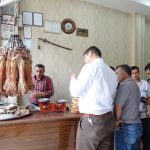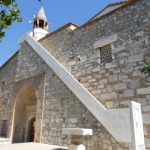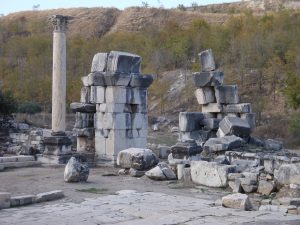 Between Milas and Yatağan, the hauntingly lovely remains of the ancient Stratonikeia lie in and around the village of Eskihisar (“Old Castle”), a settlement that was virtually abandoned in 1983 as a lignite quarry was developed right beside it (destroying part of the necropolis incidentally). Today only four families continue to live in what must once have been a wholly delightful village; their neighbours have moved away to the usual dull collection of concrete houses in the village of Yeni Eskihisar, which you bypass on your way to the site if you come from Milas.
Between Milas and Yatağan, the hauntingly lovely remains of the ancient Stratonikeia lie in and around the village of Eskihisar (“Old Castle”), a settlement that was virtually abandoned in 1983 as a lignite quarry was developed right beside it (destroying part of the necropolis incidentally). Today only four families continue to live in what must once have been a wholly delightful village; their neighbours have moved away to the usual dull collection of concrete houses in the village of Yeni Eskihisar, which you bypass on your way to the site if you come from Milas.
Stratonikeia is a place where every old Ottoman house has a piece of old Roman marble parked by its doorstep to serve as a seat on sunny days. It’s one of my favourite places in Turkey and it’s astonishing that more people don’t come here, especially as it’s not particularly difficult to get to.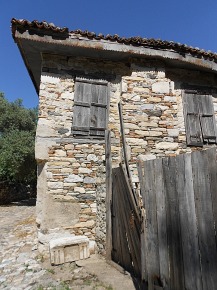
This situation may soon change as on my most recent visit (May, 2015) the shells of structures built by the entrance suggested that the site was being readied for tourism. Already the pretty old village kahvehane has reopened as a cafe.
Backstory
The Roman historian Plutarch tells a pretty story about the founding of Stratonikeia. According to him, the elderly Seleucus, one of Alexander the Great’s generals, had married a lovely young woman called Stratonice. Unfortunately his son Antiochus by a previous wife fell ill with frustrated love for his stepmother. The Greek physician, Eristratus, diagnosed the problem but told Seleucus his son was fading away for love of his own wife.
“Why don’t you give her to him then?” cried the king. Eristratus then broke the bad news that it was really Seleucus’ wife who was causing the problem, whereupon the old man agreed to let his son marry his stepmother. Antiochus then founded Stratonikeia for her.
Later, the city was home to the Chrysaoric League which united all the Carian settlements despite its having been a Hellenistic rather than Carian town. The League met at a Temple to Zeus Chrysaoreus which may have been nearby.
Around the site
As soon as you reach Stratonikeia you will realise how special it is. Just past the village sign stands the fine restored Saban Ağa Cami with a partially wooden facade. A mosque is known to have stood on the site since the 17th century when it was probably called the Tabakhane Cami. It was rebuilt in 1876 with an unusual anteroom included in the wooden portico. I was told that it had started life as a church; if so, the signs say nothing about it. 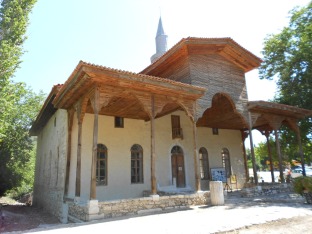
Near the mosque are the shattered remnants of a hamam (Turkish bath) that probably dates back to the 14th century when the Menteşe emirs ruled over this part of the country.
Moving away from the mosque you come at once to a cobbled village square shaded by giant plane trees and surrounded by pretty stone cottages and shops with tiled roofs, a poignant reminder that the average Turkish village was once just as picture-postcard pretty as its English counterpart. The old kahvehane (teahouse) that would once have been the focal point of village life along with the mosque has been restored but you may still find it locked.
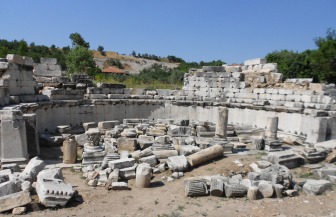 Ancient Stratonikeia is well-signposted, with the ruins, most of them dating back to Roman times, tucked away down more pretty cobbled alleyways.
Ancient Stratonikeia is well-signposted, with the ruins, most of them dating back to Roman times, tucked away down more pretty cobbled alleyways.
Probably the most imposing sight is the ancient gymnasium, a strung-out cluster of curvy marble buildings overlooked by more pretty cottages. This probably dates back to the second quarter of the 2nd century BC although expensive reconstruction seem to have taken place in the early 1st century AD.
A short walk away is an open area where archaeologists from Pamukkale University have excavated a long colonnaded street dominated by the remaining column of the huge northern gate . It has a 2nd-century monumental fountain attached to it so that those who’d just arrived along the Sacred Way from Lagina could refresh themselves.
Beyond this the Sacred Way (Kutsal Yolu) ran the entire 10km to the shrine of Hecate, the goddess of witchcraft, at Lagina. Right beside it there’s a battered stretch of city wall and a more impressive barrel-vaulted tomb with steps leading down to the burial chamber.
Inside the gate the archaeologists have also uncovered what must once have been an agora (marketplace) with rutted marble paving stones. However, many of the structures are etched with ancient crosses, suggesting that an important church must have been built here in Byzantine times. A large circular structure uncovered in 2008 looks as if it may have been a baptistry.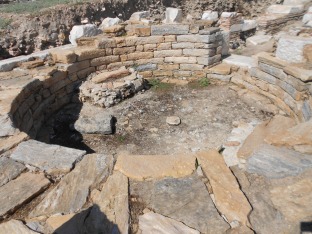 Probable Byzantine baptistry
Probable Byzantine baptistry
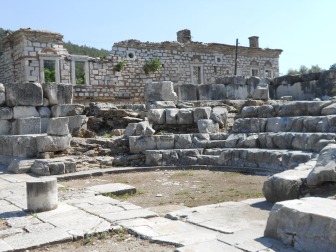 Bouleterion overlooked by 19th-century houseFollowing the signs you will eventually come to the remains of another 2nd-century hamam, its arches built into the walls of later buildings. Not far from here a staircase winds up inside a marble wall and opens out into what is thought to have been a bouleterion (council chamber) dating back to the 1st century AD, with lengthy Greek and Latin inscriptions carved into the wall and 16th- and early 17th-century Ottoman floral carvings on the outside. The Latin inscriptions indicate the fixed prices for items on sale in the market.
Bouleterion overlooked by 19th-century houseFollowing the signs you will eventually come to the remains of another 2nd-century hamam, its arches built into the walls of later buildings. Not far from here a staircase winds up inside a marble wall and opens out into what is thought to have been a bouleterion (council chamber) dating back to the 1st century AD, with lengthy Greek and Latin inscriptions carved into the wall and 16th- and early 17th-century Ottoman floral carvings on the outside. The Latin inscriptions indicate the fixed prices for items on sale in the market.
The garden of the nearby Hasan Sar Evi, the original Kazı Evi (Excavations House), provides makeshift shelter for a selection of finds from the site carefully locked away from visitors. The house has been beautifully restored although you can’t go inside it.
Signs then point you towards the remains of a theatre that in its heyday could probably have seated about 15,000 people. Originally constructed against Kadıkule Hill in the Hellenistic period, it was extensively remodelled in the 1st century AD. Right beside it is what appears to be a second stepped bouleterion or council chamber (?).
It all adds up to a wonderful place to while away a quiet few hours in complete contrast to the more familiar coastal development.
There is no accommodation at Stratonikeia and most visitors will probably stay in Bodrum. If you want more time to explore you could also base yourself in nearby Milas or, better still, in Yatağan.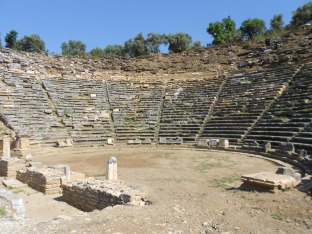
Transport info
To get to Stratonikeia by public transport take any bus heading west from Milas or Yatağan to Bodrum. Past Yatağan you will start to see evidence of excavations going on right by the road on both sides. Ask to be put off here, then clamber over the embankment on the northern side of the road which will bring you out at the back of the theatre. It’s just possible that the powers-that-be will have fenced off access from here since my 2015 visit.
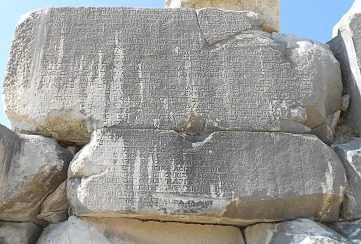 Greek inscriptions inside bouleterion
Greek inscriptions inside bouleterion
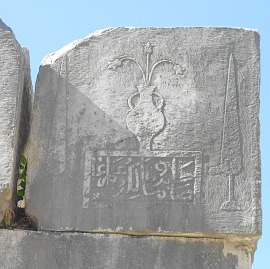 Ottoman carving on outside of bouleterion
Ottoman carving on outside of bouleterion

